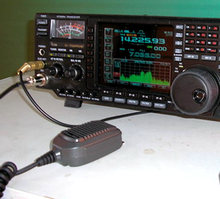This article includes a list of references, related reading, or external links, but its sources remain unclear because it lacks inline citations .(August 2020) |
In radio communication, a transceiver is an electronic device which is a combination of a radio transmitter and a receiver, hence the name. It can both transmit and receive radio waves using an antenna, for communication purposes. These two related functions are often combined in a single device to reduce manufacturing costs. The term is also used for other devices which can both transmit and receive through a communications channel, such as optical transceivers which transmit and receive light in optical fiber systems, and bus transceivers which transmit and receive digital data in computer data buses.
Contents
Radio transceivers are widely used in wireless devices. One large use is in two-way radios, which are audio transceivers used for bidirectional person-to-person voice communication. Examples are cell phones, which transmit and receive the two sides of a phone conversation using radio waves to a cell tower, cordless phones in which both the phone handset and the base station have transceivers to communicate both sides of the conversation, and land mobile radio systems like walkie-talkies and CB radios. Another large use is in wireless modems in mobile networked computer devices such laptops, pads, and cellphones, which both transmit digital data to and receive data from a wireless router. Aircraft carry automated microwave transceivers called transponders which, when they are triggered by microwaves from an air traffic control radar, transmit a coded signal back to the radar to identify the aircraft. Satellite transponders in communication satellites receive digital telecommunication data from a satellite ground station, and retransmit it to another ground station.


